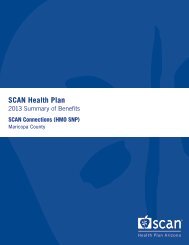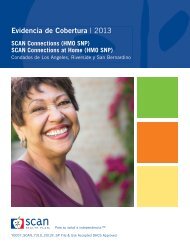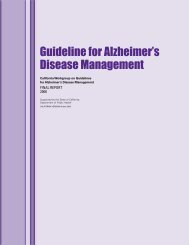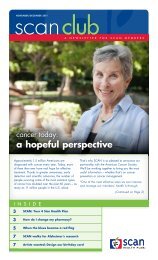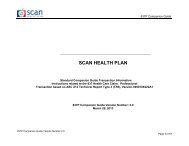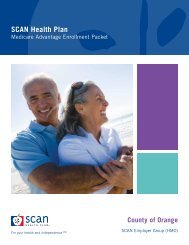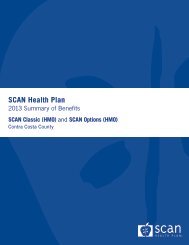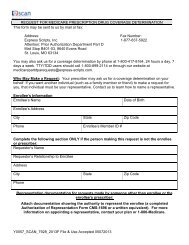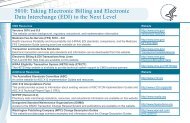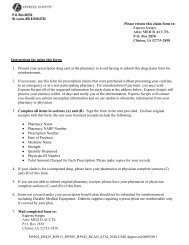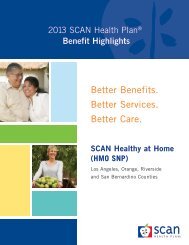Oxygen Therapy Supplies - Centers for Medicare & Medicaid Services
Oxygen Therapy Supplies - Centers for Medicare & Medicaid Services
Oxygen Therapy Supplies - Centers for Medicare & Medicaid Services
Create successful ePaper yourself
Turn your PDF publications into a flip-book with our unique Google optimized e-Paper software.
DEPARTMENT OF HEALTH AND HUMAN SERVICES<br />
<strong>Centers</strong> <strong>for</strong> <strong>Medicare</strong> & <strong>Medicaid</strong> <strong>Services</strong><br />
R<br />
Official CMS In<strong>for</strong>mation <strong>for</strong><br />
<strong>Medicare</strong> Fee-For-Service Providers<br />
<strong>Oxygen</strong> <strong>Therapy</strong> <strong>Supplies</strong>:<br />
Complying with Documentation & Coverage Requirements<br />
This fact sheet is designed to provide education on <strong>Medicare</strong> coverage of oxygen therapy<br />
supplies and to describe common Comprehensive Error Rate Testing (CERT) Program errors<br />
related to oxygen therapy. It includes a checklist of the documentation needed to support a claim<br />
submitted to <strong>Medicare</strong> <strong>for</strong> oxygen therapy supplies.<br />
The <strong>Centers</strong> <strong>for</strong> <strong>Medicare</strong> & <strong>Medicaid</strong> <strong>Services</strong> (CMS) developed the CERT Program to produce<br />
a national <strong>Medicare</strong> Fee-For-Service (FFS) improper payment rate, as required by the Improper<br />
Payments In<strong>for</strong>mation Act of 2002, and the Improper Payments Elimination and Recovery Act of<br />
2010. CERT randomly selects a statistically-valid sample of <strong>Medicare</strong> FFS claims and reviews<br />
those claims and related medical records <strong>for</strong> compliance with <strong>Medicare</strong> coverage, payment,<br />
coding, and billing rules.<br />
In order to accurately measure the per<strong>for</strong>mance of the <strong>Medicare</strong> claims processing contractors<br />
and to gain insight into the causes of errors, CMS calculates both a national <strong>Medicare</strong> FFS paid<br />
claims improper payment rate and a provider compliance improper payment rate and publishes<br />
the results of these reviews annually.<br />
CMS strives to eliminate improper payments in the <strong>Medicare</strong> Program in order to maintain the<br />
<strong>Medicare</strong> Trust Fund while protecting patients from medically unnecessary services or supplies.<br />
Common <strong>Oxygen</strong> and <strong>Oxygen</strong> Equipment Errors<br />
1. Missing documentation showing that the patient was seen by a physician within the<br />
appropriate timeframes <strong>for</strong> certification or recertification of the need <strong>for</strong> oxygen supplies.<br />
2. Missing documentation of original blood gas or saturation test results.<br />
3. Missing documentation indicating that the patient needs or is using oxygen and supplies.<br />
4. Missing documentation to show that the patient is mobile within the home<br />
(<strong>for</strong> portable oxygen).<br />
5. Missing physician order <strong>for</strong> oxygen supplies.<br />
6. Missing the most recent Certificate of Medical Necessity (CMN).<br />
ICN 904883 December 2011
Overlooked Policy Requirements<br />
1. <strong>Medicare</strong> requires home oxygen to be ordered by a physician after evaluating a<br />
patient’s medical need. This visit must occur either prior to, but no earlier than, 2 days<br />
prior to the inpatient hospital discharge date, or while the patient is in a chronic stable<br />
state. The physician notes must establish the need <strong>for</strong> oxygen based upon Local<br />
Coverage Determination (LCD) requirements and show that the visit (and test) does not<br />
exceed 30 days from the Initial Date on the CMN.<br />
2. For <strong>Medicare</strong> to pay <strong>for</strong> oxygen equipment, a patient must have both a continued need<br />
<strong>for</strong> oxygen in the home and must also be using the equipment.<br />
3. For patients to qualify <strong>for</strong> portable oxygen, they must be mobile within the home and be<br />
tested under specific conditions (during exercise or at rest).<br />
4. <strong>Medicare</strong> requires all patients who use home oxygen to first be tested either by arterial<br />
blood gas (ABG) or oximetry test (SAT). There must be a record of the test results in the<br />
physician’s notes to verify that the test occurred.<br />
<strong>Oxygen</strong> Documentation Checklist<br />
<strong>Medicare</strong> requires the following documentation <strong>for</strong> <strong>Medicare</strong> oxygen therapy:<br />
Detailed Written Order<br />
The detailed written order must include:<br />
●●<br />
●●<br />
●●<br />
●●<br />
Patient name;<br />
Detailed description of the items being provided, including:<br />
a. The means of oxygen delivery,<br />
b. The specifics of varying oxygen flow rates and/or non-continuous use of<br />
oxygen, and<br />
c. The length of need;<br />
Treating physician’s signature and date order signed; and<br />
Start date of the order (only required if the start date is different from the<br />
signature date).<br />
Coverage<br />
Home oxygen therapy is covered only if all of the following conditions are met:<br />
●●<br />
●●<br />
The treating physician has determined that the patient has a severe lung<br />
disease or hypoxia-related symptoms that might be expected to improve<br />
with oxygen therapy.<br />
The patient’s blood gas study meets the criteria stated below.<br />
}}<br />
The qualifying blood gas study was per<strong>for</strong>med by a physician or by a<br />
qualified provider or supplier of laboratory services.<br />
}}<br />
The qualifying blood gas study was obtained under the following<br />
conditions (a or b):<br />
2
●●<br />
a. If the qualifying blood gas study is per<strong>for</strong>med during an inpatient hospital stay,<br />
the reported test must be the one obtained closest to, but no earlier than, 2 days<br />
prior to the hospital discharge date; or<br />
b. If the qualifying blood gas study is not per<strong>for</strong>med during an inpatient hospital<br />
stay, the reported test must be per<strong>for</strong>med while the patient is in a chronic stable<br />
state (that is, not during a period of acute illness or an exacerbation of his or<br />
her underlying disease).<br />
Alternative treatment measures have been tried or considered and deemed<br />
clinically ineffective.<br />
<strong>Medicare</strong> Qualifying Saturation Test Results<br />
<strong>Medicare</strong> covers home oxygen therapy only if the patient’s arterial saturation test results meet<br />
the following criteria:<br />
●●<br />
●●<br />
The patient’s test results must be within 48 hours of the date of delivery, unless the<br />
arterial saturation tests were taken during an outpatient encounter or during the patient’s<br />
sleep. If tests were taken during an outpatient encounter or during the patient’s sleep,<br />
the patient’s arterial saturation test results must be within 30 days of the date of delivery.<br />
Arterial saturation test results that qualify <strong>for</strong> coverage are classified into Group I or<br />
Group II. The group determines specific CMN requirements. The criteria <strong>for</strong> each group<br />
are listed in Table 1 and Table 2 below.<br />
Table 1. Group I Criteria<br />
Patient on Room Air<br />
at Rest<br />
While awake:<br />
• Arterial oxygen<br />
saturation at or below<br />
88%; or<br />
• Arterial Partial<br />
Pressure of <strong>Oxygen</strong><br />
(PO 2 ) at or below<br />
55 mm Hg.<br />
Patient Tested During Exercise<br />
• Room air at rest arterial<br />
saturation results above<br />
56 mm Hg or an arterial oxygen<br />
saturation at or above 89%; or<br />
• Arterial saturation results during<br />
ambulation and without oxygen<br />
below 55 mm Hg or an arterial<br />
oxygen saturation at or below<br />
88%; and<br />
• Documented improvement of<br />
hypoxemia during ambulation<br />
with oxygen.<br />
Patient Tested During Sleep<br />
If arterial PO 2<br />
at or above 56 mm Hg or an<br />
arterial oxygen saturation at or above 89%<br />
while awake, additional testing must show:<br />
a. Arterial PO 2 at or below 55 mm Hg,<br />
or an arterial oxygen saturation at or<br />
below 88%, <strong>for</strong> at least 5 minutes taken<br />
during sleep; or<br />
b. Decrease in arterial PO 2<br />
of more than<br />
10 mm Hg, or a decrease in arterial<br />
oxygen saturation more than 5%, <strong>for</strong><br />
at least 5 minutes, taken during sleep<br />
associated with symptoms or signs<br />
reasonably attributable to hypoxemia.<br />
3
Table 2. Group II Criteria<br />
Patient on Room Air at Rest Patient Tested During Exercise Patient Tested During Sleep<br />
While awake:<br />
• Arterial oxygen saturation of<br />
89%; or<br />
• Arterial PO 2 of 56-59 mm Hg; and<br />
a. Dependent edema<br />
suggesting congestive<br />
heart failure;<br />
b. Pulmonary hypertension<br />
or cor pulmonale,<br />
determined by measurement<br />
of pulmonary artery<br />
pressure, gated blood pool<br />
scan, echocardiogram,<br />
or “P” pulmonale on<br />
electrocardiography (EKG)<br />
(P wave greater than 3 mm<br />
in standard leads II, III, or<br />
AVF); or<br />
c. Erythrocythemia with a<br />
hematocrit above 56%.<br />
• Arterial oxygen saturation of<br />
89%; or<br />
• Arterial PO 2 of<br />
56-59 mm Hg; and<br />
a. Dependent edema<br />
suggesting congestive<br />
heart failure;<br />
b. Pulmonary hypertension<br />
or cor pulmonale,<br />
determined by<br />
measurement of<br />
pulmonary artery<br />
pressure, gated<br />
blood pool scan,<br />
echocardiogram, or “P”<br />
pulmonale on EKG<br />
(P wave greater than 3 mm<br />
in standard leads II, III, or<br />
AVF); or<br />
c. Erythrocythemia with a<br />
hematocrit above 56%.<br />
During sleep <strong>for</strong> at least 5 minutes:<br />
• Arterial oxygen saturation of<br />
89%; or<br />
• Arterial PO 2 of 56-59 mm Hg; and<br />
a. Dependent edema<br />
suggesting congestive<br />
heart failure;<br />
b. Pulmonary hypertension or<br />
cor pulmonale, determined by<br />
measurement of pulmonary<br />
artery pressure, gated blood<br />
pool scan, echocardiogram, or<br />
“P” pulmonale on EKG (P wave<br />
greater than 3 mm in standard<br />
leads II, III, or AVF); or<br />
c. Erythrocythemia with a<br />
hematocrit above 56%.<br />
Note: A portable oxygen system is covered if the patient is mobile within the home and the<br />
qualifying blood gas study was per<strong>for</strong>med at rest while awake or during exercise.<br />
Certificate of Medical Necessity (CMN) Requirements<br />
Complete the CMN using Certificate of Medical Necessity – <strong>Oxygen</strong><br />
DME 484.03 (Form CMS-484). A completed CMN, signed and dated<br />
by the treating physician, must be kept on file by the supplier and<br />
made available upon request. Claims submitted without a valid<br />
CMN will be denied as not medically necessary. Specific CMN<br />
reporting requirements, including the type of CMN,<br />
testing, and visits by the treating physician<br />
are described in Tables 3, 4, and 5.<br />
4
Table 3. Initial CMN Requirements<br />
Initial CMN Required Testing Requirements Physician Visit Requirements<br />
1. With the first claim <strong>for</strong> home<br />
oxygen, even if the patient was<br />
on oxygen prior to <strong>Medicare</strong><br />
eligibility or the oxygen<br />
was initially covered by a<br />
<strong>Medicare</strong> Health Maintenance<br />
Organization (HMO); or<br />
2. During the first 36 months of the<br />
rental period, when there has<br />
been a change in the patient’s<br />
condition that has caused a<br />
break in medical necessity of<br />
at least 60 days plus whatever<br />
days remain in the rental<br />
month during which the need<br />
<strong>for</strong> oxygen ended. Refer to the<br />
<strong>Oxygen</strong> and <strong>Oxygen</strong> Equipment<br />
– Policy Article – Effective<br />
October 2011 (A33750)* at<br />
http://www.cms.gov/medicarecoverage-database/license/cptlicense.aspx?from=~/overviewand-quick-search.aspx&npage=/<br />
medicare-coverage-database/<br />
details/article-details.aspx&articl<br />
eId=33750&ver=33&ContrId=14<br />
0&ContrVer=2&CntrctrSelected<br />
=140*2&bc=AgCAAAAAAAAA&<br />
on the CMS website.<br />
• The blood gas study must<br />
be the most recent study<br />
obtained within 30 days prior<br />
to the Initial Date.<br />
}}<br />
For Initial Certification<br />
situation 1, there is an<br />
exception to the 30-day<br />
test requirement <strong>for</strong><br />
patients who were started<br />
on oxygen while enrolled<br />
in a <strong>Medicare</strong> HMO and<br />
transitioned to <strong>Medicare</strong><br />
FFS. For those patients,<br />
the blood gas study does<br />
not have to be obtained<br />
30 days prior to the Initial<br />
Date, but must be the<br />
most recent qualifying<br />
test obtained while in<br />
the HMO.<br />
The patient must be seen and<br />
evaluated by the treating physician<br />
within 30 days prior to the date of<br />
Initial Certification.<br />
3. When equipment is replaced<br />
because the reasonable useful<br />
lifetime of the prior equipment<br />
has been reached; or<br />
4. When equipment is replaced<br />
because of irreparable damage<br />
(a specific accident or natural<br />
disaster, such as a fire or a<br />
flood), theft, or loss of the<br />
originally dispensed equipment.<br />
Repeat blood gas testing is<br />
not required <strong>for</strong> an Initial CMN<br />
submitted <strong>for</strong> replacement<br />
equipment. Enter the most recent<br />
qualifying blood gas study value<br />
and test date. The test does not<br />
have to be within 30 days prior<br />
to the Initial Date. It could be the<br />
test result reported on the most<br />
recent prior CMN.<br />
There is no requirement <strong>for</strong> a<br />
physician visit that is specifically<br />
related to the completion of the CMN<br />
<strong>for</strong> replacement equipment.<br />
* Policy Article A33750 is the Local Coverage Article <strong>for</strong> Jurisdiction C. Similar policy<br />
articles are also available <strong>for</strong> the other three jurisdictions. All four jurisdictions have<br />
LCDs as well.<br />
5
Table 4. Recertification CMN Requirements<br />
Recertification CMN Required Testing Requirements Physician Visit Requirements<br />
1. 12 months after Initial<br />
Certification; that is, with<br />
the 13 th month’s claim,<br />
<strong>for</strong> Group I; or<br />
2. 3 months after Initial<br />
Certification; that is, the fourth<br />
month’s claim, <strong>for</strong> Group II.<br />
A Recertification CMN submitted<br />
<strong>for</strong> a patient initially meeting<br />
Group I criteria following Initial<br />
Certification situations 1 and 2<br />
should report the most recent<br />
qualifying blood gas study prior to<br />
the 13 th month of therapy.<br />
A Recertification CMN submitted<br />
<strong>for</strong> a patient initially meeting<br />
Group II criteria should report<br />
the most recent blood gas study<br />
per<strong>for</strong>med between the 61 st<br />
and 90 th day following Initial<br />
Certification. If a qualifying test<br />
is not obtained between the 61 st<br />
and 90 th day of home oxygen<br />
therapy, the patient continues to<br />
use oxygen, and a test is obtained<br />
at a later date that meets Group I<br />
or II criteria, coverage would<br />
resume beginning with the date of<br />
that test.<br />
A Recertification following Initial<br />
Certification <strong>for</strong> situations 3 and 4<br />
(replacement equipment) should<br />
report the most recent qualifying<br />
value and test date. This test does<br />
not have to be within 30 days prior<br />
to the Initial Date. It could be the<br />
test result reported on the most<br />
recent prior CMN.<br />
For patients initially meeting<br />
Group I or II criteria, the treating<br />
physician must see and re-evaluate<br />
the patient within 90 days prior to<br />
the date of any Recertification. If<br />
the treating physician sees and<br />
re-evaluates the patient after the<br />
90-day window and the patient<br />
continues to use oxygen, coverage<br />
would resume beginning with the<br />
date of that visit.<br />
There is no requirement <strong>for</strong> a<br />
physician visit that is specifically<br />
related to the completion of the CMN<br />
<strong>for</strong> replacement equipment.<br />
6
Table 5. Revised CMN Requirements<br />
Revised CMN Required Testing Requirements Physician Visit Requirements<br />
1.<br />
When the prescribed maximum<br />
flow rate changes from one of<br />
the following categories<br />
to another:<br />
a. Less than 1 Liter per Minute<br />
(LPM),<br />
b. 1-4 LPM, or<br />
c. Greater than 4 LPM.<br />
If the change is from category<br />
(a) or (b) to category (c), a<br />
repeat blood gas study with<br />
the patient on 4 LPM must be<br />
per<strong>for</strong>med.<br />
2. When the length of need<br />
expires, if the physician<br />
specified less than lifetime<br />
length of need on the most<br />
recent CMN.<br />
3. When a portable oxygen<br />
system is added subsequent<br />
to Initial Certification of a<br />
stationary system.<br />
4. When a stationary system is<br />
added subsequent to Initial<br />
Certification of a portable system.<br />
5.<br />
6.<br />
When there is a new treating<br />
physician, but the oxygen order<br />
is the same; or<br />
If there is a new supplier, and<br />
that supplier does not have the<br />
prior CMN.<br />
The blood gas study must be the<br />
most recent study obtained within<br />
30 days prior to the Initial Date.<br />
There is no requirement <strong>for</strong> a<br />
repeat blood gas study unless<br />
the initial qualifying study was<br />
per<strong>for</strong>med during sleep, in<br />
which case a repeat blood gas<br />
study must be per<strong>for</strong>med while<br />
the patient is at rest (awake) or<br />
during exercise within 30 days<br />
prior to the Revised Date.<br />
No blood gas study is required.<br />
No blood gas study is required.<br />
The Revised Certification does<br />
not have to be submitted with<br />
the claim.<br />
There is no requirement <strong>for</strong> a<br />
physician visit.<br />
There is no requirement <strong>for</strong> a<br />
physician visit.<br />
There is no requirement <strong>for</strong> a<br />
physician visit.<br />
There is no requirement <strong>for</strong> a<br />
physician visit.<br />
Note: If the indications <strong>for</strong> a Revised CMN are met at the same time that a<br />
Recertification CMN is due, file the CMN as a Recertification CMN.<br />
7
<strong>Oxygen</strong> and <strong>Oxygen</strong> Equipment<br />
<strong>Medicare</strong> allows payment on a monthly basis <strong>for</strong> oxygen and oxygen equipment <strong>for</strong> use in the<br />
patient’s home under certain conditions. Each payment <strong>for</strong> oxygen and oxygen equipment includes<br />
payment <strong>for</strong> all equipment, accessories, oxygen, and supplies that the patient needs <strong>for</strong> the entire<br />
month. After 36 months of continuous use, payment <strong>for</strong> oxygen equipment is capped, but payment<br />
can continue to be made <strong>for</strong> oxygen contents <strong>for</strong> use with liquid or gaseous systems or periodic<br />
maintenance and servicing of systems that do not require delivery of oxygen contents (that is,<br />
concentrators or transfilling equipment). The supplier of oxygen equipment in the 36 th month of<br />
use must continue to furnish the oxygen and oxygen equipment <strong>for</strong> the remainder of the 5-year<br />
reasonable useful lifetime of the equipment. It is important <strong>for</strong> suppliers to know that the patient’s<br />
need <strong>for</strong>, and use of, oxygen delivery equipment should be documented by the treating physician<br />
on a regular basis.<br />
What Do I Need to Know to Prevent Errors?<br />
1. Verify that the physician noted the need <strong>for</strong> oxygen based upon policy requirements. The<br />
visit (and test) should not exceed 30 days from the Initial Date on the CMN or 90 days<br />
from the Recertification Date.<br />
2. Ensure that your documentation shows a continued need <strong>for</strong> oxygen and continued use of<br />
the equipment by the patient.<br />
3. For portable oxygen, make sure your documentation indicates that the patient is mobile<br />
within the home. In addition, ensure the patient’s oxygen test was conducted while he or<br />
she was either exercising or at rest. If the test is conducted while the patient is asleep, the<br />
patient does not qualify <strong>for</strong> portable oxygen.<br />
4. It is important that you have the results of the qualifying test, whether ABG or SAT. Retain<br />
a copy of the test <strong>for</strong> your files in the event of an audit. The results of the test can be<br />
either printed data from the test or written in the physician’s notes.<br />
Common Misconceptions Specific to the <strong>Oxygen</strong> and <strong>Oxygen</strong> Equipment Policy<br />
Misconception: Once a patient is recertified, a supplier does not need to obtain more documentation.<br />
Fact: Please remember that <strong>Medicare</strong> should only pay <strong>for</strong> an item when it is in use by a patient.<br />
This includes oxygen. For <strong>Medicare</strong> to continue to pay <strong>for</strong> home oxygen, a patient should both<br />
need and use the equipment. There<strong>for</strong>e, the physician should regularly document the patient’s<br />
need <strong>for</strong>, and use of, oxygen equipment through the patient’s medical records.<br />
Misconception: I do not need to have a copy of the ABG or SAT score because it is listed on the CMN.<br />
Fact: While the test score is listed on the CMN, an auditing agency such as the CERT contractor<br />
can ask <strong>for</strong> documentation to ensure that the score listed on the CMN is documented by printed<br />
data from the test or from the record listed in the physician’s notes. There<strong>for</strong>e, a copy of the<br />
patient’s ABG and/or SAT score(s) should be maintained.<br />
Misconception: I do not have to maintain documentation when the 36-month cap has been<br />
met and the patient is on maintenance and service.<br />
Fact: Although the 36-month cap has been met, documentation must be maintained <strong>for</strong><br />
continued use of oxygen therapy.<br />
8
Resources<br />
●<br />
●<br />
●<br />
●<br />
●<br />
●<br />
●<br />
●<br />
Detailed education is available from the<br />
Durable Medical Equipment <strong>Medicare</strong><br />
Administrative Contractors (DME MACs)<br />
serving Jurisdictions A, B, C, and D. DME<br />
MACs provide education in a variety<br />
of <strong>for</strong>mats including: self-paced online<br />
tutorials, podcasts, video education,<br />
and webinars.<br />
For a list of seminars, workshops, and<br />
webinars, available in English and<br />
Spanish, visit http://www.cgsmedicare.<br />
com/jc on the Internet.<br />
MLN Guided Pathways to <strong>Medicare</strong> Resources<br />
MLN Educational Web Guides MLN Guided Pathways to<br />
<strong>Medicare</strong> Resources help providers gain knowledge on<br />
resources and products related to <strong>Medicare</strong> and the CMS<br />
website. For more in<strong>for</strong>mation about <strong>Medicare</strong> compliance,<br />
refer to the “Protecting the <strong>Medicare</strong> Trust Fund” section in<br />
the “MLN Guided Pathways to <strong>Medicare</strong> Resources - Basic<br />
Curriculum <strong>for</strong> Health Care Professionals, Suppliers, and<br />
Providers” booklet at http://www.cms.gov/MLNEdWebGuide/<br />
Downloads/Guided_Pathways_Basic_Booklet.pdf on the<br />
CMS website. For all other “Guided Pathways” resources,<br />
visit http://www.cms.gov/MLNEdWebGuide/30_Guided_<br />
Pathways.asp on the CMS website.<br />
For more in<strong>for</strong>mation on oxygen<br />
and oxygen equipment and documentation prior to DME claim submission, visit https://www.<br />
noridianmedicare.com/dme/train on the Internet.<br />
For more in<strong>for</strong>mation about DME, or to find your DME MAC, visit the DME Center at http://www.<br />
cms.gov/center/dme.asp on the CMS website.<br />
For more in<strong>for</strong>mation on basic billing requirements, visit the “<strong>Medicare</strong> Claims Processing Manual,”<br />
Chapter 20, at http://www.cms.gov/manuals/downloads/clm104c20.pdf on the CMS website.<br />
To download a podcast from the <strong>Medicare</strong> Learning Network ® (MLN) based on this fact sheet, visit<br />
the MLN Multimedia web page at http://www.cms.gov/MLNProducts/MLM/list.asp on the<br />
CMS website.<br />
For oxygen billing tips, refer to MLN Matters ® Special Edition Article SE1103 at http://www.cms.<br />
gov/MLNMattersArticles/Downloads/SE1103.pdf on the CMS website.<br />
For a complete list of national educational products related to provider compliance, including<br />
CERT, visit the MLN Provider Compliance web page at http://www.cms.gov/MLNProducts/45_<br />
ProviderCompliance.asp on the CMS website.<br />
R<br />
Official CMS In<strong>for</strong>mation <strong>for</strong><br />
<strong>Medicare</strong> Fee-For-Service Providers<br />
This fact sheet was current at the time it was published or uploaded onto the web. <strong>Medicare</strong> policy changes frequently so links to the<br />
source documents have been provided within the document <strong>for</strong> your reference.<br />
This fact sheet was prepared as a service to the public and is not intended to grant rights or impose obligations. This fact sheet may<br />
contain references or links to statutes, regulations, or other policy materials. The in<strong>for</strong>mation provided is only intended to be a general<br />
summary. It is not intended to take the place of either the written law or regulations. We encourage readers to review the specific<br />
statutes, regulations, and other interpretive materials <strong>for</strong> a full and accurate statement of their contents.<br />
The <strong>Medicare</strong> Learning Network ® (MLN), a registered trademark of CMS, is the brand name <strong>for</strong> official CMS educational products<br />
and in<strong>for</strong>mation <strong>for</strong> <strong>Medicare</strong> Fee-For-Service Providers. For additional in<strong>for</strong>mation, visit the MLN’s web page at http://www.cms.gov/<br />
MLNGenInfo on the CMS website.<br />
Your feedback is important to us and we use your suggestions to help us improve our educational products, services and activities<br />
and to develop products, services and activities that better meet your educational needs. To evaluate <strong>Medicare</strong> Learning Network ®<br />
(MLN) products, services and activities you have participated in, received, or downloaded, please go to http://www.cms.gov/<br />
MLNProducts and click on the link called ‘MLN Opinion Page’ in the left-hand menu and follow the instructions.<br />
Please send your suggestions related to MLN product topics or <strong>for</strong>mats to MLN@cms.hhs.gov.<br />
9




